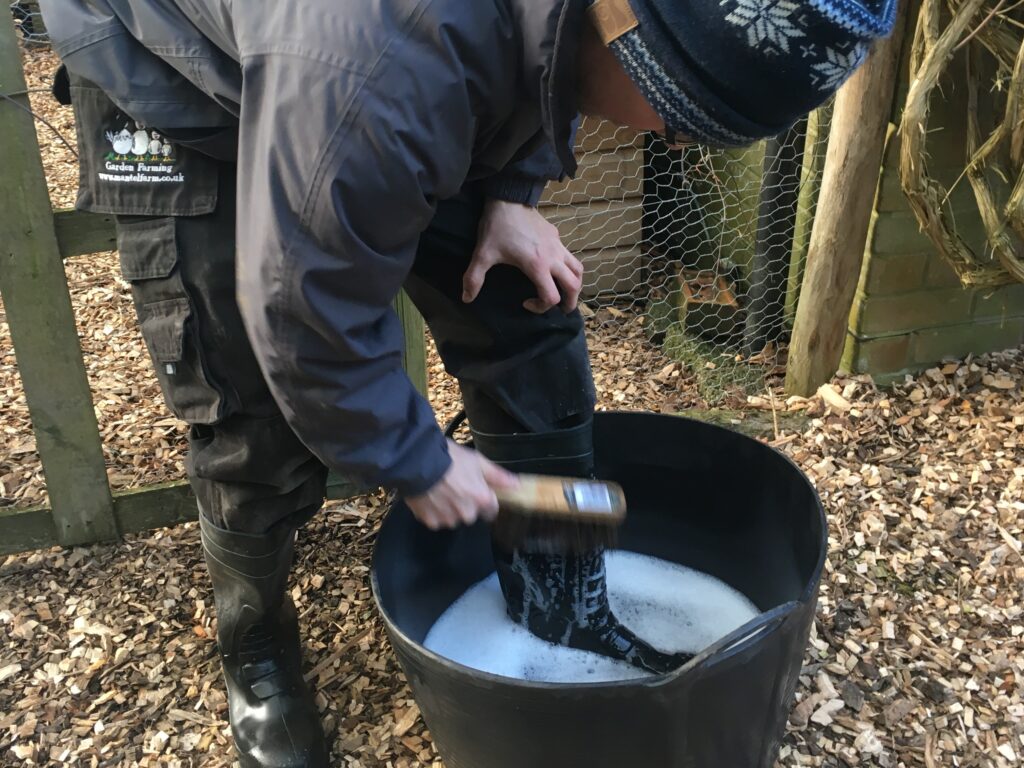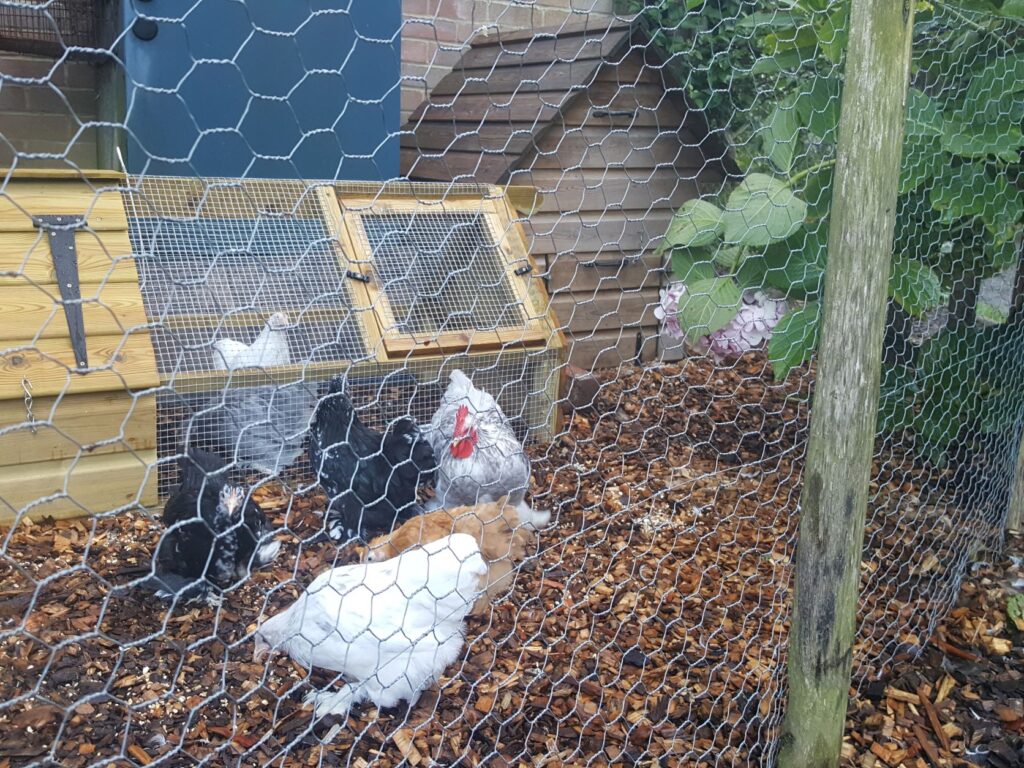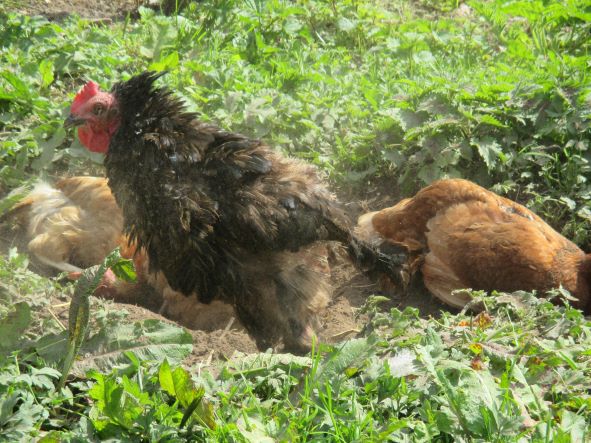
Chickens can be affected by both fleas and lice, the latter being more common and living directly on your birds whilst the chicken fleas live mainly in the bedding, jumping aboard the birds to feed.
Except in severe, unchecked circumstances neither are usually life-threatening, however, can quickly result in loss of egg production and will make your birds’ life a misery carrying a whole load of unwanted, constantly irritating passengers. Whilst these fleas and lice cannot live on you, if you are an avid handler
they can certainly survive long enough to bite.
Quick Check List:
- Chickens can be affected by both fleas and lice, the latter being more common and living directly on your birds.
- Are any birds looking lethargic, or anaemic? (noticeably loss of redness to comb, wattles and face/head in general). Loss of feathers is another common sign.
- Look for egg clusters mainly around the vent, the underside of the belly and under the wings and around the neck. The clusters are fairly-easy to spot.
- Fleas are 2-3mm long, a pale yellowish-brown colour and move very quickly.
- Even if only one bird appears to be affected by the problem, it is best to assume that all birds do have it, and all should be treated.
- Apply ‘Diatomaceous Earth’ by sprinkling the powder liberally around the inside of your housing, nesting boxes & perches. It should be also applied to you birds concentrating in the main affected areas.
- Prevention is better than cure – always provide a dust bath area with Diatom powder added.
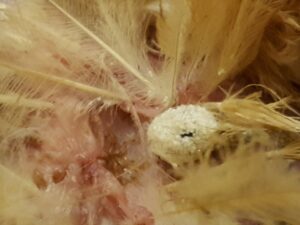
Fleas and Lice Help and Advice:
Signs to look out for:
Are any birds looking lethargic, or anemic (noticeably loss of redness to comb, wattles and face/head in general). Loss of feathers is another common sign, often self-pecking, from trying to stop the irritation (though there can be many reasons for feather loss).
Inspecting your birds:
When inspecting your birds for lice, you will find them clustering mainly around the vent (the chickens bum) and to the underside of the belly. Other places are under the wings and around the neck – basically the birds’ hotter areas. They are 2-3mm long, a pale yellowish-brown colour and move very quickly, often meaning that you must have a sharp eye to spot the first beginnings of a problem as just a few can run and disappear quicker than you can part the feathers! The egg clusters are fairly easy to spot, the main area for these being around the vent. They appear as what looks like a small, slightly flat, greyish cotton wool bud at the base of the feathers. If just a few, it is possible to simply ‘pluck’ out the affected feathers, suitably disposing of them away from your birds, then treat as below, however, if there are many egg clusters then treatment will be necessary.
Treat the whole flock:
Even if only one bird appears to be affected by the problem, it is best to assume that all birds do have it, and all should be treated. At no point should cat and dog flea treatments be applied to chickens, as some can prove fatal to them, it is best to apply a product produced for the purpose, or another that is tried, tested and guaranteed to work safely.
There are many powders on the market, we use and firmly believe in ‘Diatomaceous Earth’ (Diatom or DE for short). It is of organic origin, being a fine powder derived from a naturally occurring sedimentary rock, comprising fossilised remains of diatoms (single-celled, siliceous organisms!) Under a microscope it appears as millions of razor-sharp shards of glass. The powder works by dehydrating the chicken fleas & lice. Sprinkle the powder liberally around the inside of your birds’ housing, nesting boxes & perches. It can and should be also applied to you birds at skin level where possible, concentrating in the main affected areas. You will find it much easier with a second person helping, one to rub back the feathers, whilst the other applies the powder. It can be an interesting experience, particularly if the bird manages to start flapping her wings, you can end up more “de-flead” than the bird! Try applying the powder with an icing sugar shaker or sieve, these work well, also great for evenly spreading the powder over the flooring.
How to hold the bird:
It is best to very carefully hold the bird upside down by its legs (holding it in place until it stops struggling, this is usually quite quickly achieved). Then, working swiftly with a helper, powder the bird as necessary. In this position the wings naturally fall open, making powdering easier, and the feathers are easier to rub back, enabling you to hold the powder at skin level much more effectively.
If you have several birds to do, take an upturned dustbin lid balanced on a bucket to make an excess powder catcher; this excess powder can then be sprinkled over the flooring to save wasting it. Initially, many people may worry that holding birds upside down is likely to cause damage to legs & wellbeing, I’ve no doubt this could be the case if not undertaken in a responsible calm manner, however, we (and many others) have been using this method very successfully for years. It should be possible to powder each bird and return it to the ground, the right way up in around 30 seconds.
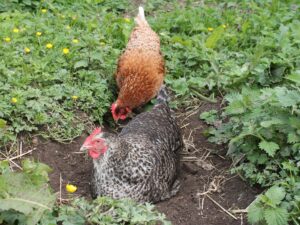
Provide a dust bath:
General good poultry husbandry, with regular and thorough cleaning out is always best. You should also provide your birds with a ‘dust bath’ as this is a birds’ natural way of keeping themselves clean, in good condition and ridding themselves of fleas, lice and other mites as best they can.
If you have a decent sized run, or your birds can occasionally free range the garden, they will very quickly find a spot to form a dust bowl. In dry weather, this could be almost anywhere, flower beds etc, or during damp weather maybe under a dense bush or at the base of a tree such as Leylandii, however, during times of prolonged wet conditions, small or exposed runs, your birds will be unable to dust bath. We then strongly suggest that you provide them with a dust tray, with a suitable dust mix in it. Either bring this in and out according to the weather or make a covered area within the run for it. The tray can be purpose made (eg. 16” x 16” (40cm x 40cm) and 4” (10cm) deep), or something you have knocking around that might do the job of similar size. If you have enough space, bigger is also good as dust bathing in the sun is a social event, your birds will love to ‘do it together’!
The ‘dust mix’ can be purchased, or mixed up yourself, and may contain a mix of dry dusty earth, sand, fine sawdust & wood ash. In addition, sprinkle over the top or mix in a good amount of the Diatom powder, hence, DIY treatment – the ultimate prevention!
New fleas and lice will be hatching from the eggs every 7-14 days, so we advise repeating the process 3 times at 5 day intervals once an infestation is discovered as this could be at any point in the cycle. However preventative treatment is always better than having to cure a problem.



